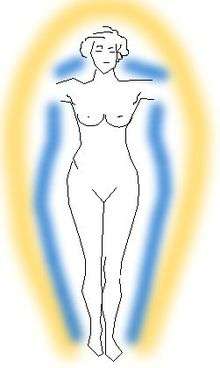Walter John Kilner

Walter John Kilner, M.D. B.A., M.B. (Cantab.) M.R.C.P., etc. (1847–1920) was a medical electrician at St. Thomas Hospital, London. There, from 1879 to 1893, he was in charge of electrotherapy. He was also in private medical practice, in Ladbroke Grove, London.
He wrote papers on a range of subjects but is today best remembered for his late study The Human Atmosphere. In 1883 he became a Member of the Royal College of Physicians. In his spare time he was a keen chess player.
The Human Atmosphere
In 1911 Kilner published one of the first western medical studies of the "Human Atmosphere" or Aura, proposing its existence, nature and possible use in medical diagnosis and prognosis. In its conviction that the human energy field is an indicator of health and mood, Kilner's study resembles the later work of Harold Saxton Burr. However, while Burr relied upon voltmeter readings, Kilner, working before the advent of semiconductor technology, attempted to invent devices by which the naked eye might be trained to observe "auric" activity which, he hypothesised, was probably ultraviolet radiation, stating that the phenomena he saw were not affected by electromagnets.[1]
Glass slides or "Kilner Screens"[2] containing alcoholic solutions of variously coloured dyes, including a blue coal-tar dye called "dicyanin" were used as filters in "Kilner Goggles" which, together with lights, were held to train the eyes to perceive electromagnetic radiation outside the normal spectrum of visible light.[3] After being so trained, one could dispense with the apparatus. Kilner did not recommend merely viewing the subject through these lenses.
According to his study, Kilner and his associates were able, on many occasions, to perceive auric formations, which he called the Etheric Double, the Inner Aura and the Outer Aura, extending several inches from patients' naked bodies, and his book gave instructions by which the reader might construct and use similar goggles.[1]
Francis J. Rebman, a friend of Kilner supported his research in America.[4]
A drawback to Kilner's method was the scarcity and toxicity of the chemicals he recommended. Later, the biologist Oscar Bagnall[5] recommended substituting the dye pinacyanol (dissolved in triethanolamine) but this dye is also not easy to obtain. Carl Edwin Lindgren has stated that cobalt blue and purple glass may be substituted for the dyes used by Kilner and Bagnall.[6]
In 1920 a revised edition of his book was published under the title The Human Aura. Kilner's work was well-timed for the heyday of Theosophy and his findings were incorporated into Arthur E. Powell's book The Etheric Double.[7] Powell rightly made clear that Kilner had expressly differentiated between his own work and the clairvoyance and eastern systems of spiritualism.
Critical reception
In the British Medical Journal (BMJ) a review for Kilner's research stated that although Kilner contended the aura is a "purely physical phenomenon", evidence does not support this view. Scientists from the BMJ attempted to replicate Kilner's experiments but the results were negative. The review concluded that "Dr. Kilner has failed to convince us that his "aura" is more real than Macbeth's visionary dagger."[8]
American scholar J. Gordon Melton has written:
Kilner's research was largely dismissed by later researchers on light and perception, and the results he reported were seen as artifacts of the observer's own optic process rather than reflective of any emanation being produced by the subject being observed. These findings did not prevent the marketing of Kilner goggles, advertisements for which appeared in Esoteric periodicals as late as the 1970s.[9]
Skeptical investigator Joe Nickell has described Kilner's research as pseudoscience, noting that he "uncritically accepted the validity of non-existent N-rays and clairvoyant powers."[10]
Publications
- The Human Atmosphere (1911)
See also
- Aura (paranormal)
- L-field of Harold Saxton Burr
- Kirlian Photography
- Morphogenetic field of biologist Rupert Sheldrake
- Orgone energy of Wilhelm Reich
- Prana in Ayurveda and Yoga
- Qi or ch'i or ki in several Asian cultures, especially Chinese
- Vitalism
References
- 1 2 Kilner, Walter J., The Human Atmosphere, or the Aura Made Visible by the aid of Chemical Screens, 1911, reprinted as "The Human Aura" by Citadel Press, NY, 1965, ISBN 0-8065-0545-1. The Aura, by Walter J. Kilner. Introd. by Sibyl Ferguson. New York, S. Weiser, 1973.
- ↑ Raymond J. Corsini The Dictionary of Psychology, Psychology Press 1999 p.524
- ↑ Williams, William F. (2002). Encyclopedia of Pseudoscience: From Alien Abductions to Zone Therapy. Facts on File Inc. pp. 176-177. ISBN 978-0816050802
- ↑ The Daily Journal-Gazette from Mattoon, Illinois. August 19, 1911. p. 3. Rebman published a booklet on the subject The Human Aura: A Brief Explication of Dr. Kilner's Discovery of Means for Observing the Human Atmosphere. (1912).
- ↑ Bagnall, Oscar. (1937). The Origin and Properties of the Human Aura. Kegan Paul, Trench, Trübner and Company.
- ↑ Lindgren, Carl Edwin. (2005). Capturing the Aura. Blue Dolphin Publishing. p. 16. ISBN 978-1577330721
- ↑ Powell, Arthur E. (1925). The Etheric Double and Allied Phenomena. Theosophical Publishing House.
- ↑ The Human Atmosphere by Walter J. Kilner. British Medical Journal. Vol. 1, No. 2662 (Jan. 6, 1912), pp. 21-22.
- ↑ Melton, J. Gordon. (2013). The Encyclopedia of Religious Phenomena. Visible Ink. p. 17. ISBN 978-1578592098
- ↑ Nickell, Joe. (1993). Looking for a Miracle: Weeping Icons, Relics, Stigmata, Visions & Healing Cures. Prometheus Books. pp. 210-211. ISBN 1-57392-680-9